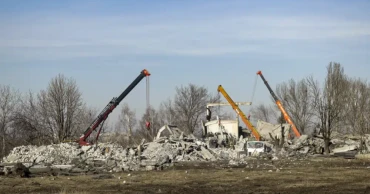Russian soldiers
Sitting ducks? Russian military flaws seen in troop deaths
The Russian military’s top brass came under increasing scrutiny Wednesday as more details emerged of how at least 89 Russian soldiers, and possibly many more, were killed in a Ukrainian artillery attack on a single building.
The scene last weekend in the Russian-held eastern Ukrainian town of Makiivka, where the soldiers were temporarily stationed, appears to have been a recipe for disaster. Hundreds of Russian troops were reportedly clustered in a building close to the front line, well within range of Ukraine’s Western-supplied precision artillery, possibly sitting close to an ammunition store and perhaps unwittingly helping Kyiv’s forces to zero in on them.
It was one of the deadliest single attacks on the Kremlin’s forces since the war began more than 10 months ago and the highest death toll in a single incident acknowledged so far by either side in the conflict.
Ukraine’s armed forces claimed the Makiivka strike killed around 400 Russian soldiers housed in a vocational school building. About 300 more of them were wounded, officials alleged. It wasn't possible to verify either side's claims due to the fighting.
The Russian military sought to blame the soldiers for their own deaths. Gen. Lt. Sergei Sevryukov said in a statement late Tuesday that their phone signals allowed Kyiv’s forces to “determine the coordinates of the location of military personnel” and launch a strike.
Emily Ferris, a research fellow on Russia and Eurasia at the Royal United Services Institute in London, told The Associated Press it is “very hard to verify” whether cellphone signaling and geolocation were to blame for the accurate strike.
She noted that Russian soldiers on active duty are forbidden from using their phones — exactly because there have been so many instances in recent years of their being used for targeting, including by both sides in the Ukraine war. The conflict has made ample use of modern technology.
Read more: Putin orders weekend truce in Ukraine; Kyiv won’t take part
She also noted that blaming the soldiers themselves was a “helpful narrative” for Moscow as it helps deflect criticism and steer attention toward the official cellphone ban.
Russian President Vladimir Putin sought to move the conversation along, too, as he took part via video link in a sending-off ceremony Wednesday for a frigate equipped with the Russian navy’s new hypersonic missiles.
Putin said the Zircon missiles that the Admiral Gorshkov frigate was carrying were a “unique weapon,” capable of flying at nine times the speed of sound and with a range of 1,000 kilometers (620 miles). Russia says the missiles can't be intercepted.
Meanwhile, away from the battlefields, France said Wednesday it will send French-made AMX-10 RC light tanks to Ukraine — the first tanks from a Western European country — following an afternoon phone call between French President Emmanuel Macron and Ukrainian President Volodymyr Zelenskyy on Wednesday.
The French presidency didn't say how many tanks would be delivered and when. The NATO member has given Ukraine anti-tank and air defense missiles and rocket launchers.
Later Wednesday, President Joe Biden confirmed that the U.S. is considering sending Bradley Fighting Vehicles to Ukraine. The Bradley is a medium armored combat vehicle that can carry about 10 personnel, or be configured to carry additional ammunition or communications equipment.
The Pentagon has already provided Ukraine with more than 2,000 combat vehicles, including 477 Mine Resistant Ambush Protected Vehicles and more than 1,200 Humvees.
The weekend Makiivka strike seemed to be the latest blow to the Kremlin’s military prestige as it struggles to advance the invasion of its neighbor.
But Ferris, the analyst, said “there should be a bit of caution around leaning too heavily on this (attack) as a sign of (the) Russian army’s weakness.”
As details of the strike have trickled out in recent days, some observers detected military sloppiness at the root of so many deaths.
U.K. intelligence officials said Wednesday that Moscow’s “unprofessional” military practices were likely partly to blame for the high casualties.
“Given the extent of the damage, there is a realistic possibility that ammunition was being stored near to troop accommodation, which detonated during the strike, creating secondary explosions,” the U.K. Defense Ministry said on Twitter.
Read more: Ukraine to get French combat vehicles in 'first' such move
In the same post, the ministry said the building struck by Ukrainian missiles was little more than 12 kilometers (7.5 miles) from the front line, within “one of the most contested areas of the conflict,” in the partially Russian-occupied Donetsk region.
“The Russian military has a record of unsafe ammunition storage from well before the current war, but this incident highlights how unprofessional practices contribute to Russia’s high casualty rate,” the update added.
The Russian Defense Ministry, in a rare admission of losses, initially said the strike killed 63 troops. But as emergency crews searched the ruins, the death toll mounted. The regiment’s deputy commander was among the dead.
That stirred renewed criticism inside Russia of the way the broader military campaign is being handled by the Ministry of Defense.
Vladlen Tatarsky, a well-known military blogger, accused Russian generals of “demonstrating their own stupidity and misunderstanding of what’s going on (among) the troops, where everyone has cellphones.”
“Moreover, in places where there’s coverage, artillery fire is often adjusted by phone. There are simply no other ways,” Tatarsky wrote in a Telegram post.
Others blamed the decision to station hundreds of troops in one place. “The cellphone story is not too convincing,” military blogger Semyon Pegov wrote. “The only remedy is not to house personnel en masse in large buildings. Simply not to house 500 people in one place but spread them across 10 different locations.”
Unconfirmed reports in Russian-language media said the victims were mobilized reservists from the region of Samara, in southwestern Russia.
The Institute for the Study of War saw in the incident further evidence that Moscow isn’t properly utilizing the reservists it began calling up last September.
“Systemic failures in Russia’s force generation apparatus continue to plague personnel capabilities to the detriment of Russian operational capacity in Ukraine,” the think tank said in a report late Tuesday.
Ferris, of the Royal United Services Institute, said the Makiivka strike shows the Russian army is more interested in growing its number of troops, not in training them in wartime skills.
“That’s really how Russia conducts a lot of its warfare — by overwhelming the enemy with volume, with people,” she said. "The Kremlin view, unfortunately, is that soldiers’ lives are expendable.”
In a grinding battle of attrition, Russian forces have pressed their offensive on Bakhmut in Donetsk despite heavy losses. The Wagner Group, a private military contractor owned by Yevgeny Prigozhin, a millionaire businessman with close ties to Putin, has spearheaded the Bakhmut offensive.
U.S. intelligence officials have determined that convicts Wagner pulled from prisons accounted for 90% of Russian casualties in fighting for Bakhmut, according to a senior administration official who requested anonymity to discuss the finding.
The White House said last month that intelligence findings showed Wagner had some 50,000 personnel fighting in Ukraine, including 40,000 recruited convicts. The U.S. assesses that Wagner is spending about $100 million a month in the fight.
2 years ago
Russia says phone use allowed Ukraine to target its troops
Unauthorized use of cell phones by Russian soldiers led to a deadly Ukrainian rocket attack on the facility where they were stationed, the Russian military said late Tuesday, raising the death toll from the weekend attack to 89.
Gen. Lt. Sergei Sevryukov said in a statement that phone signals allowed Kyiv’s forces to “determine the coordinates of the location of military personnel” and launch a strike. Sevryukov said unspecified measures were being taken to “prevent similar tragic incidents in the future” and promised to punish officials responsible for the infraction.
Read more: Russia, shaken by Ukrainian strike, could step up drone use
The attack, one of the deadliest on the Kremlin’s forces since the start of the war over 10 months ago, occurred one minute into the new year, according to Sevryukov.
Ukrainian forces fired six rockets from a U.S.-provided HIMARS multiple launch system at a building “in the area of Makiivka” where the soldiers were stationed. Two rockets were downed but four hit the building and detonated, prompting the collapse of the structure. The Russian Defense Ministry initially said the strike killed 63 troops. But as emergency crews sifted through the rubble of the building, the death toll has grown to 89, Sevryukov said on Tuesday. The regiment’s deputy commander was among the dead.
Other, unconfirmed reports put the death toll much higher.
The Strategic Communications Directorate of Ukraine’s armed forces claimed Sunday that around 400 mobilized Russian soldiers were killed in a vocational school building in Makiivka and about 300 more were wounded. That claim couldn’t be independently verified. The Russian statement said the strike occurred “in the area of Makiivka” and didn’t mention the vocational school.
Read more:
The attack marked yet another setback for the Kremlin’s bogged-down war effort in Ukraine, undermined by a successful Ukrainian counteroffensive. It stirred renewed criticism inside Russia of the way the war is being conducted.
Unconfirmed reports in Russian-language media said the victims were mobilized reservists from the region.
2 years ago
Russia’s Chernobyl seizure seen as nuclear risk ‘nightmare’
Here in the dirt of one of the world’s most radioactive places, Russian soldiers dug trenches. Ukrainian officials worry they were, in effect, digging their own graves.
Thousands of tanks and troops rumbled into the forested Chernobyl exclusion zone in the earliest hours of Russia’s invasion of Ukraine in February, churning up highly contaminated soil from the site of the 1986 accident that was the world’s worst nuclear disaster.
For more than a month, some Russian soldiers bunked in the earth within sight of the massive structure built to contain radiation from the damaged Chernobyl nuclear reactor. A close inspection of their trenches was impossible because even walking on the dirt is discouraged.
As the 36th anniversary of the April 26, 1986, disaster approaches and Russia’s invasion continues, it’s clear that Chernobyl — a relic of the Cold War — was never prepared for this.
With scientists and others watching in disbelief from afar, Russian forces flew over the long-closed plant, ignoring the restricted airspace around it. They held personnel still working at the plant at gunpoint during a marathon shift of more than a month, with employees sleeping on tabletops and eating just twice a day.
Even now, weeks after the Russians left, “I need to calm down,” the plant’s main security engineer, Valerii Semenov, told The Associated Press. He worked 35 days straight, sleeping only three hours a night, rationing cigarettes and staying on even after the Russians allowed a shift change.
“I was afraid they would install something and damage the system,” he said in an interview.
Workers kept the Russians from the most dangerous areas, but in what Semenov called the worst situation he has seen in his 30 years at Chernobyl, the plant was without electricity, relying on diesel generators to support the critical work of circulating water for cooling the spent fuel rods.
“It was very dangerous to act in this way,” said Maksym Shevchuck, the deputy head of the state agency managing the exclusion zone. He was scared by it all.
Also Read: Russians leave Chernobyl; Ukraine braces for renewed attacks
Russia’s invasion marks the first time that occupying a nuclear plant was part of a nation’s war strategy, said Rebecca Harms, former president of the Greens group in the European Parliament, who has visited Chernobyl several times. She called it a “nightmare” scenario in which “every nuclear plant can be used like a pre-installed nuclear bomb.”
A visit to the exclusion zone, more desolate than usual, found that the invasion risked a catastrophe worse than the original explosion and fire at Chernobyl that sent radioactive material into the atmosphere and became a symbol of the Soviet Union’s stumbling final years. Billions of dollars were spent by the international community, including Russia, to stabilize and secure the area.
Now authorities are working with Ukraine’s defense ministry on ways to protect Chernobyl’s most critical places. At the top of the list are anti-drone systems and anti-tank barriers, along with a system to protect against warplanes and helicopters.
None of it will matter much if Russian President Vladimir Putin resorts to nuclear weapons, which Shevchuck says he can’t rule out anymore.
“I understand they can use any kind of weapon and they can do any awful thing,” he said.
Chernobyl needs special international protection with a robust U.N. mandate, Harms said. As with the original disaster, the risks are not only to Ukraine but to nearby Belarus and beyond.
“It depends from where the wind blows,” she said.
After watching thousands of Soviet soldiers work to contain the effects of the 1986 accident, sometimes with no protection, Harms and others were shocked at the Russian soldiers’ disregard for safety, or their ignorance, in the recent invasion.
Some soldiers even stole highly radioactive materials as souvenirs or possibly to sell.
“I think from movies they have the imagination that all dangerous small things are very valuable,” Shevchuck said.
He believes hundreds or thousands of soldiers damaged their health, likely with little idea of the consequences, despite plant workers’ warnings to their commanders.
“Most of the soldiers were around 20 years old,” he said. “All these actions proves that their management, and in Russia in general, human life equals like zero.”
The full extent of Russia’s activities in the Chernobyl exclusion zone is still unknown, especially because the troops scattered mines that the Ukrainian military is still searching for. Some have detonated, further disturbing the radioactive ground. The Russians also set several forest fires, which have been put out.
Ukrainian authorities can’t monitor radiation levels across the zone because Russian soldiers stole the main server for the system, severing the connection on March 2. The International Atomic Energy Agency said Saturday it still wasn’t receiving remote data from its monitoring systems. The Russians even took Chernobyl staffers’ personal radiation monitors.
In the communications center, one of the buildings in the zone not overgrown by nature, the Russians looted and left a carpet of shattered glass. The building felt deeply of the 1980s, with a map on a wall still showing the Soviet Union. Someone at some point had taken a pink marker and traced Ukraine’s border.
Also Read: Russians leave Chernobyl site as fighting rages elsewher
In normal times, about 6,000 people work in the zone, about half of them at the nuclear plant. When the Russians invaded, most workers were told to evacuate immediately. Now about 100 are left at the nuclear plant and 100 are elsewhere.
Semenov, the security engineer, recalled the Russians checking the remaining workers for what they called radicals.
“We said, ‘Look at our documents, 90% of us are originally from Russia,’” he said. “But we’re patriots of our country,” meaning Ukraine.
When the Russians hurriedly departed March 31 as part of a withdrawal from the region that left behind scorched tanks and traumatized communities, they took more than 150 Ukrainian national guard members into Belarus. Shevchuck fears they’re now in Russia.
In their rush, the Russians gave nuclear plant managers a choice: Sign a document saying the soldiers had protected the site and there were no complaints, or be taken into Belarus. The managers signed.
One protective measure the Russians did appear to take was leaving open a line routing communications from the nuclear plant through the workers’ town of Slavutych and on to authorities in Ukraine’s capital, Kyiv. It was used several times, Shevchuck said.
“I think they understood it should be for their safety,” he said. The IAEA said Tuesday the plant is now able to contact Ukraine’s nuclear regulator directly.
Another Ukrainian nuclear plant, at Zaporizhzhia in southeastern Ukraine, remains under Russian control. It is the largest in Europe.
Shevchuck, like other Ukrainians, has had it with Putin.
“We’re inviting him inside the new safe confinement shelter,” he said. “Then we will close it.”
3 years ago





